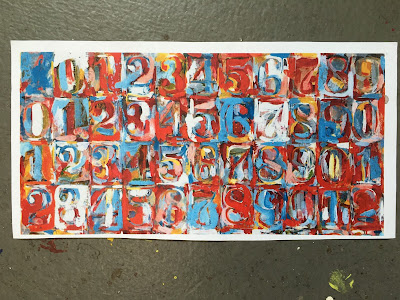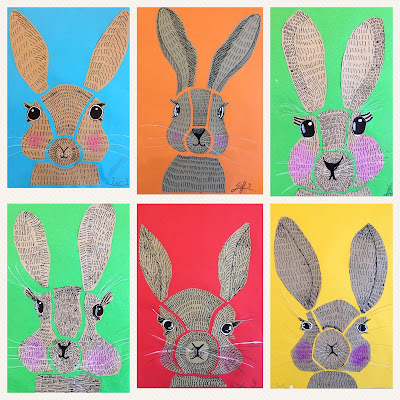
 |
| Jasper Johns |
After exploring several other American artists associated with Pop art who working in the 50's and 60's (Warhol, Thiebaud, Lichtenstein) we looked at the work of American artist Jasper Johns (1930) who crosses categories from Pop-art, to Neo-dada, to Abstract expressionism.
The name of the game is EMPHASIS and BALANCE.
For this project we focused on his letter art. We noticed that his letters are simultaneously camouflaged and revealed against a busy background. We noticed that he used stencils, which he painted over or around, or sticker letters, which he painted over and later removed, revealing the under-paint.
We noticed also that he used a limited palette of mostly primary colors, allowing these occasionally to mix, creating oranges and greens, but for the most part, his middle blue, bright yellow and strong red steal the show, adding an intense visual excitement and energy to his work. Limited white is used to soften, to push back, to add contrast and to emphasize his letters.
Analyzing his brushstroke, we noticed that he used quick brush strokes to lay down dabs, lines and area of color. In order to allow his colorful letters to reveal themselves against am equally colorful background, Johns added suggestion of contour lines, touches of white, or a contrasting dabs or dashes of color to push the letter into the foreground.
Achieving a similar emphasis for our letters was undeniably our biggest challenge for this project. We also had to ensure that each square, each housing a unique letter, was distinct from its neighboring square. Not an easy task!
Process:
We began by dividing our 30x40 cm paper into 25 squares (5x6cm across, 5x8cm down). There are 26 letters, so we squished the 'I' and 'J' tightly together into one square. The kids loved this trick.
Then we traced the ABC's with aluminum stencils into the center of each square with pencil. Next, we started adding dabs and dashes of color to our letters. Working with one color at a time, we moved our brush around the paper to add a bit of one color to all letters. In order to avoid a too perfect and systematic application of color, and to have a more balanced feel, we were mindful that some letters might have more yellow, for example, and some might have less. Each letter, after all, should have a totally unique color combo, and contribute to the balance and harmony of the whole piece. That means moving our colors and textures around the paper.
Once all letters had dabs of all colors, we begin coloring in the background squares. We attempted to create a hard edge between squares in order to emphasis each one, but outlining them was not allowed. Instead, hard edges had to be created by dabs, dashes, and contrasting color choice. The background squares were painted in such a way that the letters both blended (color and texture) AND were emphasized. More dabbing was added and colors were adjusted to our letters to get just the right balance. The use of white was handy for this.
These turned out so beautifully.
Kids 7-11
Kids 7-12
























